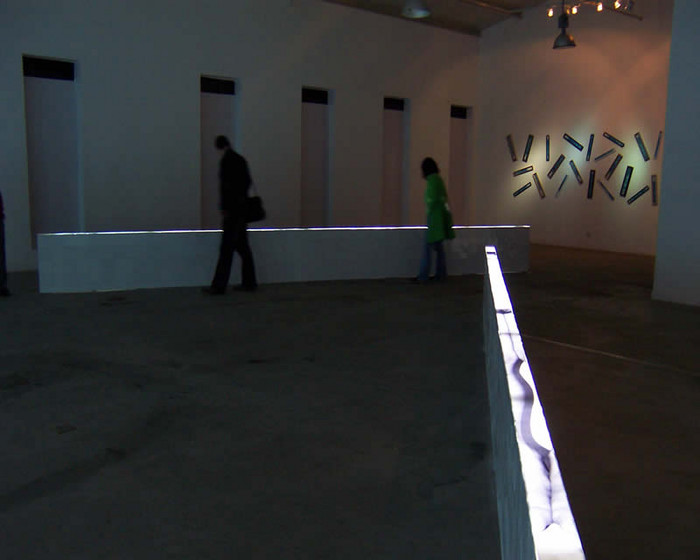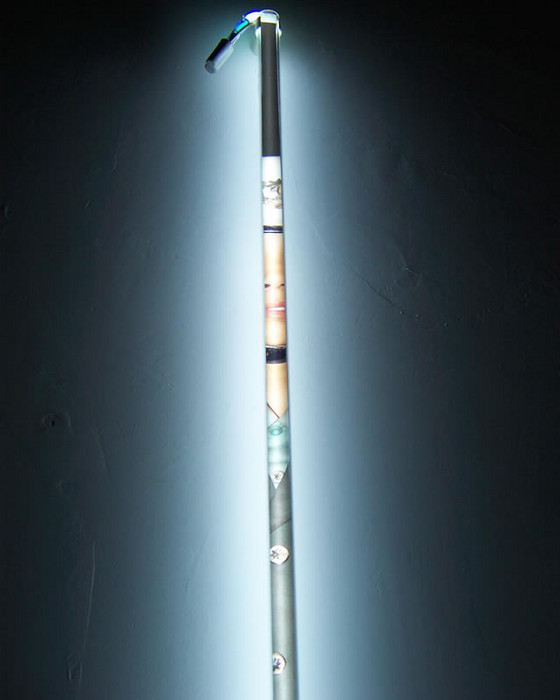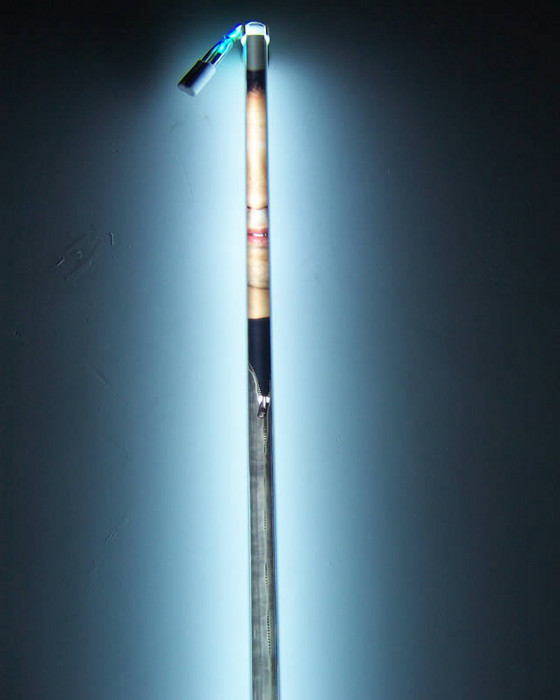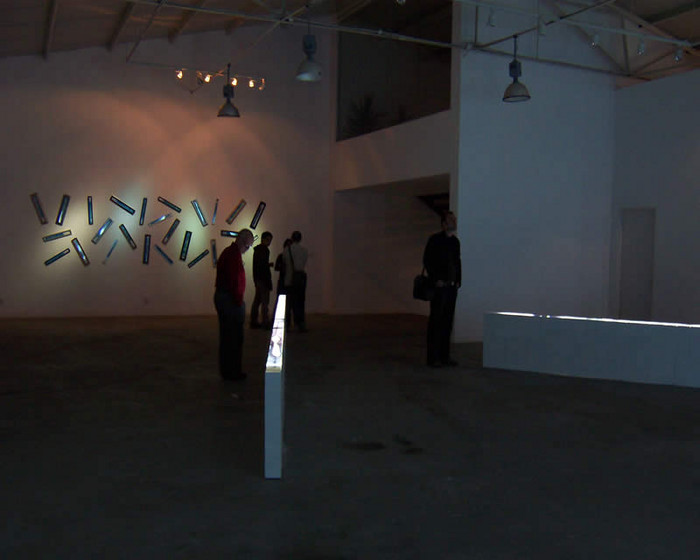Designed Meaninglessness - Wang Peng's Solo Exhibition
15 Oct - 06 Nov 2005
Designed Meaninglessness
Curator:Carol Lu
Opening :3-6pm, Sat. October 15, 2005
Exhibition dates: October 15-November 6
Venue : Platform China
Address: Inside East End Art Zone, 319-1 Caochangdi, Cuigezhuang, Chaoyang District (Opposite Guanghantang Antique Furniture)
Opening Hours :Daily 11 am—6.30 pm
Contact :010-8596 3413, pinkstudio2002@yahoo.com.cn
Thanks :www.pengwang.org
Designed Meaninglessness- Wang Peng's Solo Exhibition
Wang Peng is an artist born in the early 1960s. Like most artists born in the same period of time, he has witnessed and fully experienced the transition of Chinese contemporary art from non-existence to existence, from being underground to being aboveground, from being outside of the wall to being inside of the wall, from loneliness to liveliness, from being avant-garde to being fashionable, from impoverishment to richness. Wang Peng's personal track is also universal to a certain extent, shared among a certain number of Chinese artists. He left his hometown in Shangdong Province to enter the prestigious affiliated middle school of the Central Academy of Fine Arts, went on to study in the Central Academy of Fine Arts, taught at the Central Academy of Fine Arts after graduation, migrated to the States in the mid 90s, returned to China in 2000 and has subsequently settled down in Beijing since then. Likewise, his art practice has evolved from solely relying on paintbrushes to giving up paintbrushes in favor of other media, a model of development embraced by many practicing Chinese artists as well. In the last two decades plus, Wang Peng has been diligently making a great range of installations, performances, photography and technology-related art projects, mainly recognized for their exceptional concepts and concise visual languages. The transition and impact of the overall political and cultural climate in China, the different experiences of living and working in China and abroad, the change of the artist's own identities and living environments, his musing of art and experimentation and exploration of the forms of art, have all left lasting imprints on Wang Peng's work produced from various periods of time.
As one of the early veterans of Chinese avant-garde, Wang Peng created a highly conceptual piece called “Wall” in 1993 and with which posed a head-on confrontation with the intense cultural and political atmosphere in China at that time. He built an uncompromising bricked wall right at the entrance to the gallery space that was supposed to host his show, which was the one and only piece of work in this exhibition. What was ironic was that on the second day of the show, the manager of the gallery asked Wang Peng to take down the “Wall” that he had scheduled to show for three days due to the “tight situation.” Such a helpless outcome turned into a compelling proof of the value and force relevant to our reality in this art piece.
Since then, a few of Wang Peng's solo shows all took the form of presenting a time-related, performance-based, interactive and conceptual piece of independent artwork each, including several performance-based happenings, for instance, he locked the audience in the exhibition space without giving them any pre-warning; he took up residence in a pavilion by the moat of the Forbidden City in Beijing; and he walked across the width of a city carrying a piece of cotton thread which he kept on leaving behind as he pressed on. The research and exploration of media is also a main focus of Wang Peng's art practice. While living in the States, Wang Peng made a breakthrough in his experimentation of media and began to conceive computer-based art projects. He spent a few years studying and researching on computers intensively and produced a series of multimedia works featuring computer and technology as both the starting point and the media for his ideas. While his work involved profound thinking and complicated making, the artist managed to present them in the simplest and most accessible manners. In one of his computer-related project, the audience only had to click on a website designed by Wang Peng to send the images of their desktops to Wang's computer.
Photography - another primary direction of Wang Peng's practice carries on his constant attempts to establish individual identities and continuing exploration and expansion of art forms. Wang who believes in being “less” and “sharp,” allows this concise and comprehensive style to penetrate into his art practice. There are manipulated photographs of urban landscapes and portraits through computer post-production or enhanced perspective, paralleling documentary photos of Mao's statues from different sites, and “sectioned” photos of human bodies, which are exhibited in this latest solo exhibition of his. While attempting to play around with and develop the formal languages of photography, some of Wang Peng's photography works that feature images of Marx, Engles, Lenin and Chairman Mao as well as Tian'anmen Square reveal the inseparable bond the artist has instinctively with the disturbing public revolutionary memory on one hand, and demonstrate the artist's sensitivity towards and perplexity over political and individual identities.
“Inheritance” and “Identity” are two groups of photography installations central to Wang Peng's solo exhibition this time. He has taken a series of full-body and naked pictures of models, cut out vertically and proportionally the middle section from each of them, and incorporated them into two different groups of installations. In “Inheritance,” he blows up and “fragments” a male and a female naked picture and lies them on top of two 7-meter long and 9 cm wide podiums, both of which are completely covered in utilitarian white tiles. The two podiums are desolately placed in the middle of the exhibition space, with light seeping timidly from the bottom of the podiums, as if they were two unattended operating-tables. The remaining 10-plus strips of fragments of male and female body portraits were each inserted into a tiny and lengthy glass tube lit from behind. They are lined up in pairs evenly on the walls of the exhibition space, preserved and showcased in the same way as samples are handled in a lab. In this fraction of Wang Peng's body of work, the form can be understood as content; his work is neither plain illustration of sociology, culture, morality and politics. In Wang Peng's meticulous design, we are able to understand better the “realistic” issue and rationale of his work through focusing on the work itself. Wang Peng has employed a seemingly “scientific” methodology of sampling and analyzing in order to research and represent the condition of the totality through individual fragments that have both specialty and bear the functions of samples. Thus the artist generates a discussion on individual identity and value. However, when confronted with an overbearing public voice that is “rough,” “hoarse,” and “indecisive,” how much further can the impact of such a still, squeamish and uninterrupted experimental space as constructed by the artist be spread to?
Curator:Carol Lu
Opening :3-6pm, Sat. October 15, 2005
Exhibition dates: October 15-November 6
Venue : Platform China
Address: Inside East End Art Zone, 319-1 Caochangdi, Cuigezhuang, Chaoyang District (Opposite Guanghantang Antique Furniture)
Opening Hours :Daily 11 am—6.30 pm
Contact :010-8596 3413, pinkstudio2002@yahoo.com.cn
Thanks :www.pengwang.org
Designed Meaninglessness- Wang Peng's Solo Exhibition
Wang Peng is an artist born in the early 1960s. Like most artists born in the same period of time, he has witnessed and fully experienced the transition of Chinese contemporary art from non-existence to existence, from being underground to being aboveground, from being outside of the wall to being inside of the wall, from loneliness to liveliness, from being avant-garde to being fashionable, from impoverishment to richness. Wang Peng's personal track is also universal to a certain extent, shared among a certain number of Chinese artists. He left his hometown in Shangdong Province to enter the prestigious affiliated middle school of the Central Academy of Fine Arts, went on to study in the Central Academy of Fine Arts, taught at the Central Academy of Fine Arts after graduation, migrated to the States in the mid 90s, returned to China in 2000 and has subsequently settled down in Beijing since then. Likewise, his art practice has evolved from solely relying on paintbrushes to giving up paintbrushes in favor of other media, a model of development embraced by many practicing Chinese artists as well. In the last two decades plus, Wang Peng has been diligently making a great range of installations, performances, photography and technology-related art projects, mainly recognized for their exceptional concepts and concise visual languages. The transition and impact of the overall political and cultural climate in China, the different experiences of living and working in China and abroad, the change of the artist's own identities and living environments, his musing of art and experimentation and exploration of the forms of art, have all left lasting imprints on Wang Peng's work produced from various periods of time.
As one of the early veterans of Chinese avant-garde, Wang Peng created a highly conceptual piece called “Wall” in 1993 and with which posed a head-on confrontation with the intense cultural and political atmosphere in China at that time. He built an uncompromising bricked wall right at the entrance to the gallery space that was supposed to host his show, which was the one and only piece of work in this exhibition. What was ironic was that on the second day of the show, the manager of the gallery asked Wang Peng to take down the “Wall” that he had scheduled to show for three days due to the “tight situation.” Such a helpless outcome turned into a compelling proof of the value and force relevant to our reality in this art piece.
Since then, a few of Wang Peng's solo shows all took the form of presenting a time-related, performance-based, interactive and conceptual piece of independent artwork each, including several performance-based happenings, for instance, he locked the audience in the exhibition space without giving them any pre-warning; he took up residence in a pavilion by the moat of the Forbidden City in Beijing; and he walked across the width of a city carrying a piece of cotton thread which he kept on leaving behind as he pressed on. The research and exploration of media is also a main focus of Wang Peng's art practice. While living in the States, Wang Peng made a breakthrough in his experimentation of media and began to conceive computer-based art projects. He spent a few years studying and researching on computers intensively and produced a series of multimedia works featuring computer and technology as both the starting point and the media for his ideas. While his work involved profound thinking and complicated making, the artist managed to present them in the simplest and most accessible manners. In one of his computer-related project, the audience only had to click on a website designed by Wang Peng to send the images of their desktops to Wang's computer.
Photography - another primary direction of Wang Peng's practice carries on his constant attempts to establish individual identities and continuing exploration and expansion of art forms. Wang who believes in being “less” and “sharp,” allows this concise and comprehensive style to penetrate into his art practice. There are manipulated photographs of urban landscapes and portraits through computer post-production or enhanced perspective, paralleling documentary photos of Mao's statues from different sites, and “sectioned” photos of human bodies, which are exhibited in this latest solo exhibition of his. While attempting to play around with and develop the formal languages of photography, some of Wang Peng's photography works that feature images of Marx, Engles, Lenin and Chairman Mao as well as Tian'anmen Square reveal the inseparable bond the artist has instinctively with the disturbing public revolutionary memory on one hand, and demonstrate the artist's sensitivity towards and perplexity over political and individual identities.
“Inheritance” and “Identity” are two groups of photography installations central to Wang Peng's solo exhibition this time. He has taken a series of full-body and naked pictures of models, cut out vertically and proportionally the middle section from each of them, and incorporated them into two different groups of installations. In “Inheritance,” he blows up and “fragments” a male and a female naked picture and lies them on top of two 7-meter long and 9 cm wide podiums, both of which are completely covered in utilitarian white tiles. The two podiums are desolately placed in the middle of the exhibition space, with light seeping timidly from the bottom of the podiums, as if they were two unattended operating-tables. The remaining 10-plus strips of fragments of male and female body portraits were each inserted into a tiny and lengthy glass tube lit from behind. They are lined up in pairs evenly on the walls of the exhibition space, preserved and showcased in the same way as samples are handled in a lab. In this fraction of Wang Peng's body of work, the form can be understood as content; his work is neither plain illustration of sociology, culture, morality and politics. In Wang Peng's meticulous design, we are able to understand better the “realistic” issue and rationale of his work through focusing on the work itself. Wang Peng has employed a seemingly “scientific” methodology of sampling and analyzing in order to research and represent the condition of the totality through individual fragments that have both specialty and bear the functions of samples. Thus the artist generates a discussion on individual identity and value. However, when confronted with an overbearing public voice that is “rough,” “hoarse,” and “indecisive,” how much further can the impact of such a still, squeamish and uninterrupted experimental space as constructed by the artist be spread to?





